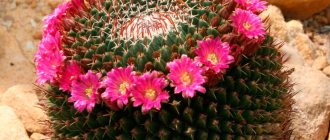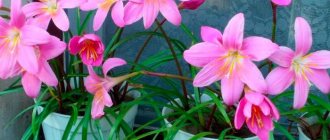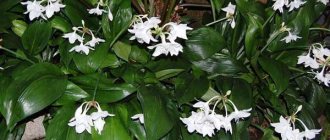What do you need to know?
Modern stores offer everything you need to create favorable living conditions and long-lasting flowering. It is important to follow the correct care and breeding steps: correct pot, morning watering, spring-summer feeding, rare transplants, temperature and light conditions.
If you were given an orchid in a pot or you bought the plant yourself, it will be important to learn how to care for this rather capricious flower and how to monitor its health. Growing rules depend on the type of flower , on the substrate in which it grows in the store, and also on what it was fed with.
Important : Any type of orchid develops favorably at temperatures from 18 to 27 degrees during the day and 13-24 degrees at night!
Factors of competent care
Many people are afraid to purchase orchids, fearing that they will not be able to care for the plant properly. In fact, the flower is not as whimsical as it seems.
But we have to agree that any type of orchid needs specific care.
The most important point in caring for flowers is properly organized lighting. Light is on par with proper feeding and regular watering. Even a lack of moisture is not as bad for orchids as a lack of lighting.
But don’t think that placing a flower pot in a bright room is enough. The duration of daylight for this type of plant should be 12-15 hours. This means that in winter you will have to additionally install daylight lamps.
But direct sunlight can also have a detrimental effect on orchids. Therefore, it is necessary to ensure that in summer the flowers do not remain on the south side of the windowsill. They need to be removed in partial shade. They do not like plants and heat. The optimal temperature will be 20-23 degrees.
Important! You need to look carefully at the orchid leaves. If they have withered and are yellowish, it means that the plant is being affected by too much light. On the contrary, darkening of the leaves indicates a lack of lighting.
Photo
In the photo below you will see flowers called “orchids” growing in pots, and you will understand how plants should look if they are properly cared for.
High humidity
For orchids, high humidity in the room in which they are located is very important. 60-70% is the optimal humidity level for this plant.
In summer, air humidity is maintained much better than in winter. This occurs due to operating heating devices that dry the air space.
Nowadays, it is not so difficult to provide the necessary conditions for air humidity; it is enough to purchase a humidifier or an indoor fountain. If they are not available, you can use a spray bottle to irrigate the leaves. The most important thing is that the water does not get on the flowers and is at room temperature.
Wet leaves and roots must be protected from cold air and drafts. Orchids are just as susceptible to disease as children, so you need to make sure there are no drafts in the room.
Conditions of keeping and breeding
Orchids require different care than houseplants . There are several distinguishing criteria.
- Transparent pot. It is easier to control the condition of the root system, whether it is rotting. A healthy plant has light green or pearl colored roots.
- Special substrate. The plant grows in a special substrate consisting of several components:
- bark;
- sphagnum moss;
- peat;
- Styrofoam;
- expanded clay
- For irrigation, soft, melt or rain water, boiled or settled, is required. Do not water the orchid with running water.
- For proper growth and development of an orchid, moisture and regular spraying are necessary.
Read more about the conditions for keeping orchids here.
What influences the quality of care?
Depending on the conditions of detention, many parts of the orchids may be damaged. And with proper care, they will indicate the health of the plant.
The roots of a plant will indicate proper care if they are green (with abundant watering) or silver-gray (orchids with dry bark) in color.
Leaves must be free of plaque, punctures, mold and stains. A blooming orchid indicates good care; with poor care, there are no flowers on the plant.
Tips for beginners on how to properly care for a flower at home
Proper care of a plant involves features depending on the time of year, type of flower, and flowering.
in winter
During the winter season, orchids go into a dormant state . In December and January, the plant does not need fertilizer. Watering becomes rare, once a week. An influx of fresh air is necessary to aerate the roots. Daily spraying is needed or the pot needs to be placed in wet pebbles.
As February begins, the length of daylight increases. At this time, orchids begin to wake up and lay flower stalks. From this point on, watering becomes more frequent and fertilizers are added. If the location of the flower is on the sunny side and the temperature rises, the number of sprays of the flower increases. Regular ventilation is required.
We recommend watching a video about caring for orchids in winter:
In the spring
Spring - preparation for the summer period.
Intensive growth begins in March, so you need to water and feed regularly. It is important to ensure that the plant is not exposed to sunburn after winter shade. On the sunny side, during the daytime it is better to shade the plant. In addition to growth, pests become more active. Regular inspection of the plant for the presence of parasites and treatment are necessary procedures in the spring . The beginning of April is the flowering period, so spraying, watering and fertilizing are needed regularly. And in May, after warm weather sets in, the pot with the plant should be taken outside.
In summer
In summer, orchids feel better, because the climate is close to their natural one. The homeland of orchids is the tropics and in addition to temperature, humidity and shading are necessary. Starting from June, plants need to be frequently sprayed and the room ventilated, preventing the development of bacteria and rotting of the roots. If in May it was still impossible to put the pots outside, then in June is the time to do this.
Starting in July, during the period of active sun, it is important to prevent sunburn . Therefore, watering and spraying are carried out early in the morning and in the evening, after sunset. During the daytime, creating shade is a must. It is important to monitor the roots to prevent the development of fungal growths.
Attention : At the end of summer, with the beginning of August, the sun is no longer so active, but watering, spraying and fertilizing remain in the same regime as in July. If your plants are outside, it's time to bring them indoors.
We recommend watching a video about caring for orchids in the summer:
in autumn
In autumn, some types of orchids still bloom and send out arrows . But the regime of watering, spraying and fertilizing needs to be reduced, preparing the plants for the winter dormant period. You can no longer shade orchids. The sun is not so active and burns will not appear. Starting from October and November, some plants lose their leaves and turn yellow.
It is necessary to reduce watering and lower the temperature. From the moment the heating is turned on, it is necessary to humidify the air in the room and spray it. If the orchid is blooming, then lighting is necessary, since daylight hours are already short.
By following the basics of caring for plants at certain times of the year, you can get long and frequent flowering . The plant will feel good and will not require additional costs. But, there are features not only at different times of the year. Find out more about how to help an orchid survive the cold season here.
How to make an orchid bloom again?
You can force an orchid to bloom before the next full flowering period without cutting off the remaining green and elastic peduncle. In this case, new branches with buds will appear from dormant buds within 2-3 months, but there will be few flowers.
In mature and healthy plants, flowering can be stimulated in one of these ways:
- Ensure differences in daily temperatures. When the average temperature outside at night reaches +18-20°C, take the plant out to the balcony or terrace, and during the day bring it into a room with a temperature of 24-28°C. A day/night temperature difference of 4-6°C is enough to spur phalaenopsis to flower. Repeat the procedure for two weeks.
- Reduce watering. Increase the interval between waterings so that the substrate has time to dry thoroughly. Return to the previous regime after the appearance of flower stalks. This method can be practiced at any time of the year, except for periods when the air temperature is above +30°C.
- Increase lighting. For phalaenopsis to bloom, a 12-hour daylight hours and good lighting are required. In winter and early spring, orchids thrive on southern windowsills.
- Use fertilizers high in phosphorus and potassium. There should be a minimum amount of nitrogen in such fertilizers.
An orchid blooming is an unforgettable sight!
Annual flowering of an orchid in a pot is possible only with strict adherence to all care rules: regular watering and fertilizing, maintaining optimal humidity and temperature conditions at home.
How to care for different types - differences
Differences in care also depend on the type of plant. Each type requires a special approach.
Phalaenopsis
The most common type. It is important to maintain a temperature of 16 to 24 degrees. The humidity level is desirable 40-50%, lighting 9-10 hours on a shaded window. Watering - by immersing the pot in water. Feeding in winter - once a month. In summer, weekly during watering. The substrate must contain bark without peat and foam .
We recommend watching a video about the rules of caring for Phalaenopsis orchids:
Dendrobium
The main rule in care is the difference in temperatures in winter and summer. In summer the temperature ranges from 18-25 degrees, in winter 12-18. The humidity level required is higher than for phalaenopsis. Additional moisture, aquariums or wet pebbles are necessary. Watering mode is regular. Feeding during watering during the flowering period. The substrate consists of bark and moss.
We recommend watching a video about the rules of caring for Dendrobium orchids:
Cumbria
This species is demanding on lighting. Light is needed at least 12 hours a day. If there is not enough lighting in winter, it will get dark. A temperature difference is also necessary. 13-16 degrees at night and 17-23 during the day. The preferred substrate is bark, coconut fibers and coal . During the flowering period and the dormant period, the care requirements are different.
We recommend watching a video about the rules for caring for Cambria orchids:
Transfer
Typically, an orchid is replanted every 2-3 years, completely changing the substrate and pot. Replanting is not carried out during the flowering period, with the exception of rotting of the root system, the appearance of pests, excessive growth of roots, salinity or decomposition of the substrate.
Soil selection
Phalaenopsis do not grow in ordinary soil. They require a special substrate in which the roots can “breathe” freely and dry quickly.
The main component of the potting mix for phalaenopsis is pine bark. You can use solid bark as a substrate or add to it:
- sphagnum moss (allows you to increase the moisture capacity of the mixture);
- coconut chips, coconut fiber (raising, moisture-absorbing components);
- charcoal;
- fine expanded clay;
- pieces of foam.
Soil for orchids: bark, coal, moss.
You can also buy ready-made substrates for orchids in stores. For example, “Fertile substrate for orchid plants” from Charodey (composed of: pine bark, charcoal, sphagnum).
Choosing a pot
When replanting, choose a plastic transparent pot for phalaenopsis, the diameter of which is 2-3 cm larger than the previous one. A prerequisite is the presence of holes at the bottom for drainage. Ideally, the holes will also be on the walls of the pot, this will allow the roots to “breathe” to their full potential.
Don't look at the unsightly appearance of such containers. The plastic pot can be installed in any decorative flowerpot, highlighting the beauty of your orchid.
The transparent walls of the pot allow you to assess the condition of the roots and their need for watering. In addition, the roots of phalaenopsis participate in photosynthesis, so they need light for normal development.
Transplantation process
Before transplanting, water the orchid well to reduce the risk of injury to the root system.
Then do the following:
- Carefully remove the orchid from the pot, holding it as close to the roots as possible.
- Remove as much substrate (bark, moss, etc.) from the root ball as possible.
- Inspect the roots. Trim the soft, brown or black parts back to healthy tissue. Treat the sections with crushed coal, cinnamon or fungicidal agents (Maxim, Vitaros).
- Place a layer of substrate 1-2 cm thick at the bottom of the new pot. It will act as drainage, so place large pieces of bark or expanded clay there.
- Place the plant in a new pot. Add fresh nutrient substrate, distributing it evenly between the roots of the plant.
- Even if you use only bark as a substrate, place a layer of sphagnum moss on top of it. It will help the aerial roots, which dry out instantly after watering, to receive the right amount of moisture.
When replanting, distribute the substrate evenly between the roots.
After transplantation, caring for the orchid should be as gentle as possible: place it in a shaded and warm place, water it for the first time no earlier than after 5 days.
Actions before and after flowering
When the buds open, the orchid requires special attention.:
- Even during the formation of buds, watering should be doubled.
- During the flowering period, the temperature at night should be increased by 5-7 degrees.
Actions after flowering:
- After flowering, you need to cut off the old peduncle.
- Feed the orchid with mineral fertilizer.
- During the dormant period, watering is reduced, the plant must gain strength for new flower stalks.
Types of photosynthesis in orchids
Photosynthesis is the process of formation of organic substances from carbon dioxide (CO2) and water (H2O) in light using the pigment chlorophyll, which is found in the chloroplasts of plant cells.
In chloroplasts, carbon dioxide and water, through a complex interaction with chlorophyll, form oxygen (O2) and glucose (C6H12O6), which is then converted into starch, fiber, fats and vitamins, which is the building material for new plant cells and organs.
An orchid, absorbing light energy, converts it into the energy of chemical bonds and accumulates it in the form of organic compounds.
During respiration, the reverse process occurs - the breakdown of complex organic compounds into simpler ones; the accumulated organic matter is consumed, releasing the energy necessary for plants to carry out growth processes and many other vital functions. Breathing occurs both during the day and at night.
Carbon dioxide that enters the plant during photosynthesis and leaves it during respiration uses the same “gates” for passage - stomata, which are located on leaves, stems, peduncles and flowers.
Through these same stomata, plants release oxygen released during photosynthesis, and also absorb and evaporate excess water. The work of stomata, which regulates the influx, transformation and release of carbon dioxide, is directly related to the type of photosynthesis in orchids.
Currently, several types of photosynthesis have been identified in orchids: C3, C4, CAM (Crassulacea Acid Metabolism) and C3-CAM (self-perpetuating photosynthesis).
- During C3 photosynthesis, carbon dioxide enters the plant through open stomata, both during the day and at night.
- During C4 photosynthesis, the stomata are partially covered during the day.
Such photosynthesis is an adaptation of plants to survive drought, high temperatures, salinity of the substrate and lack of carbon dioxide. The peculiarity of C3 photosynthesis is that the absorption of carbon dioxide occurs in one place of the leaf, and its processing in another.
So far, this type of metabolism has been found in a small number of orchids, but its wider distribution, as well as its combination with CAM photosynthesis (C4-CAM photosynthesis), is quite possible.
During CAM photosynthesis, plants close all stomata during the day to avoid excessive water loss, and the absorption and conversion of carbon dioxide into malic acid or malate occurs only at night. Desert plants—cacti and succulents—use exactly the same type of carbon storage.
CAM photosynthesis is found in many genera from the subfamily Epidendroideae: Angraecum, Coelogyne, Cy rubidium, Oncidium and Yar.
Self-switching C3-CAM photosynthesis appears to be quite widespread among epiphytic and lithophytic orchids from regions with a clear alternation of dry and wet seasons.
Under favorable climatic conditions (optimal temperature, sufficient light), the stomata of these orchids are open during the day, carbon dioxide enters the plant during the day, and they function like ordinary plants with C3 photosynthesis.
But as soon as the conditions change dramatically (lack of water, lack of light, a strong decrease in night temperatures, excess salts in irrigation water, etc.), the orchid switches to the night consumption of carbon dioxide, but in the CAM type.
CAM orchids close their stomata during the day to minimize water loss. They breathe and absorb carbon dioxide and water only in the dark, at low temperatures and high humidity.
Carbon dioxide absorbed at night is converted through a complex of complex chemical reactions into malic acid. In the light, malic acid moves from the sites of synthesis to the organs of the orchid and is used by the plant as a carbon donor.
Almost all orchids with thick, fleshy leaves are prone to self-switching C3 - CAM photosynthesis, this is especially true for monopodially growing orchids, including Phalaenopsis .
In conditions of high air humidity and good light, plants consume carbon dioxide, resorting to C3 photosynthesis, leaving stomata open during the day, quickly increase biomass and bloom easily.
But as soon as the conditions for keeping orchids deteriorate, you, almost imperceptibly for yourself, become the owner of a completely different CAM plant, whose leaves thin out, become smaller and grow more slowly.
A practical guide for beginners from A to Z
There are several points that are important after purchase.
Adaptation
Immediately after purchase, it is better to keep the orchid separately from other house plants . Do not feed or water for two weeks. The orchid must get used to the new microclimate. After this time, you can move the pot to the window.
We recommend watching a video about adapting an orchid after purchase:
Choosing a pot
The optimal container for an orchid is a plastic transparent pot. Plastic does not allow the plant to dry out or, on the contrary, rot. It is convenient to use and durable. A transparent container allows you to monitor the condition of the orchid's root system. It shows how moisture is consumed and how the substrate dries. The main thing in an orchid pot is to ensure the outflow of moisture, ventilate the roots, and safely remove large roots that extend beyond the pot.
We recommend watching a video about choosing a pot for an orchid:
An orchid needs a special substrate . These plants do not grow in the ground. It consists of bark, moss, foam plastic, expanded clay, and charcoal.
Transfer
After adaptation, some flowers require transplantation. There is no need to treat the roots or leaves.
During a normal adaptation period, the orchid activates its defenses. Transplantation is necessary for the plant to grow properly and form a root system .
You need to take it out of the pot, let the roots dry and plant it in a suitable substrate. If the orchid is immediately planted in the substrate, replanting is not required for about 2 years.
We recommend watching a video about proper orchid transplantation:
Lighting
The lighting determines whether the plant will bloom . With a lack of light, the leaves will stretch out and darken, and there will be no flower stalks. Orchids prefer a lot of diffused light. Direct sunlight can cause burns. If the flower is exposed to direct sunlight, the plant needs to be darkened.
In autumn, sun activity decreases, and there is no need to darken the plant. A dormant period begins, during which new flower stalks are formed. The duration of daylight should be at least 10 hours. In winter, in our latitudes, additional lighting with lamps will be required.
Temperature
Particular attention should be paid to the temperature difference between day and night. But almost all types of orchids feel great at temperatures of 18-27 degrees during the day and 13-24 degrees at night. Find out more about air temperature as a guarantee of orchid health here.
Watering and spraying
Orchids cannot tolerate stagnant moisture . If there is too much moisture, the roots can rot and the leaves become soggy. And the plant tolerates periods of drought better than high humidity, since the roots are able to absorb liquid for future use. Increased watering is required only for some species, as well as during the period of throwing out flower stalks and flowering itself.
The best watering method is to immerse the flower pot in a container of warm water. Spraying is required. From a special spray bottle, in the morning or evening, when the sun is not active, the orchid is irrigated with warm, settled water. In winter, spraying is also necessary, especially when the heating is turned on and the room is extremely dry.
During the flowering period, you need to make sure that water does not get on the buds and flowers . It is better to irrigate the top layer of soil and leaves.
Tip : In winter, at low temperatures and short daylight hours, the plant does not need abundant watering. During the dormant period, it is also necessary to reduce watering to a minimum.
We recommend watching a video about the types of watering of different orchids:
Top dressing
Orchids do not need constant feeding . This is necessary during the period of intensive growth and flowering. Fertilizers must be applied during watering once every 2-3 weeks. The fertilizer must be special for orchids. You cannot apply fertilizers intended for other flowers.
We recommend watching a video about the rules of feeding orchids:
Reproduction
There are several ways to propagate an orchid. This is reproduction by children, layering and vegetative. Propagation by babies is propagation by new small plants that appear on the plant. This usually happens when there is a large amount of nitrogen.
If children appear, you can wait until the roots appear, carefully separate them from the main plant and plant them in a separate pot. Reproduction by layering requires the construction of a greenhouse over the bent part of the stem . The leafless shoot in the greenhouse needs to be moistened, kept warm, and soon buds will appear, and then new plants with roots and leaves.
After the roots appear, young plants need to be separated from the mother shoot, transplanted into a separate pot and kept in the greenhouse for some time.
Vegetative propagation involves dividing a large plant with a strong root system into several different plants. Separated plants need to be watered and sprayed a little until new leaves and shoots appear . This is a sign that the plant has taken root and is doing well.
Orchid care at home
To understand how to care for an orchid in a pot, you need to know its living conditions in nature. And, if possible, try to recreate them in your apartment.
Phalaenopsis is an epiphyte, that is, in its homeland, in tropical forests, it grows not in the ground, but on trees, its roots clinging to the bark. Therefore, at home, he prefers bright diffused light, high humidity, rare abundant watering, and as soil - bark and all kinds of forest “garbage” (moss, crushed coal, pieces of stones, branches, etc.).
Wild purple phalaenopsis growing in the forests of Thailand. Imitating an orchid's natural habitat is one of the best ways to care for it.
Let's consider all the necessary conditions for the successful growth and flowering of a tropical plant when kept at home.
Lighting and placement
The orchid feels comfortable in a well-lit place, but protected from direct sunlight. The best option is the window sill of a western or eastern window. Also in winter you can place an orchid in a pot on a south-facing window sill, and in summer - on a bright northern one.
The duration of daylight for flowering should be at least 12 hours. To meet this condition in the autumn-winter period, you can use additional lighting - fluorescent or LED lamps.
Do not place the tropical plant near radiators and air conditioners. These devices dry out the air, lead to wrinkling of leaves, dropping flowers and buds.
Another taboo for flowering phalaenopsis is cut flowers or fruits located nearby. They emit ethylene, which shortens its flowering period.
Temperature
One of the reasons for the popularity of the butterfly orchid is that it grows at normal temperatures that are comfortable for humans.
The ideal air temperature during the day is 24-28°C, and at night – 18-20°C. For flowering, the contrast of day/night temperatures is a prerequisite. In the wild, it is the fall in autumn temperatures that causes phalaenopsis to bloom.
Humidity
The most suitable level of air humidity is 50-70%. To create such high humidity, it is necessary to ensure the constant evaporation of water around the orchid. How to do it?
There are several options for increasing air humidity:
- Place the orchid pot on a tray with expanded clay or gravel. Pour water into the bottom of the pan so that the bottom of the pot does not touch the water. It is more convenient to use not ordinary pallets, but special trays with grates, which are sold in garden centers and stores.
- Place containers of water near the plants.
- Use humidifiers.
Also, to ensure that the orchid receives the moisture it needs, spray its leaves and aerial roots with a fine spray bottle. You can do this 1-2 times a day.
Pallets of water and pebbles (or expanded clay) allow moisture to evaporate and humidify the air
Watering
Success in growing orchids largely depends on a properly established watering regime.
When overdried, the leaves wrinkle, turn yellow, and the flowers quickly fly away. Unpleasant. But the effect of the bay on epiphytic phalaenopsis is even worse: the root system, being in a constantly wet state, rots. Often the rotting process develops rapidly, the plant ends up without roots and, if resuscitation measures are not carried out, dies.
Instructions for caring for orchids at home often include the following recommendations: in summer, watering should be done every 5-7 days, in winter - 1-2 times a month.
However, it is not advisable to blindly follow such recommendations and water the plant on a schedule (for example, every Wednesday). When setting up an irrigation regime, it would be more correct to focus on the condition of the roots and substrate.
How to determine when it’s time to water an orchid?
- The roots became light gray, matte. Roots in a “saturated” state with water are green or silver-green, shiny.
- The substrate is completely dry.
- There is no condensation on the walls of the pot. If there is evaporation, then it is too early to water.
The frequency of watering largely depends on the time of year, temperature, air humidity and the substrate used.
- In summer, at high temperatures, phalaenopsis will have to be watered more often than in winter.
- The higher the air humidity, the less the need for watering.
- The better the air circulation around the roots, the faster they dry out and the more often they need moisture.
- Different substrates have different moisture holding capacity. Sphagnum moss retains water for a relatively long time, pine bark holds water less. Pieces of foam plastic and coal dry out the fastest. Therefore, an orchid in sphagnum needs to be watered less often than in bark, polystyrene foam and coal.
Water your orchid in the morning so that the water has completely evaporated from the foliage by nightfall. Use warm water (about 30°C), ideally soft, boiled or settled.
How to water an orchid correctly? Here are some ways:
- Immersion. Place the pot in a deep, wide container (basin, pan, sink). Start watering the orchid from the top so that the water fills the container just below the rim of the pot. Allow the substrate to soak in water for 15-20 minutes. Then remove the pot from the container, let any excess water drain, and place the plant back in bright, indirect light. Irrigation by immersion is often combined with fertilizing by adding fertilizer to the irrigation water (but diluted 2-3 times weaker than indicated on the package).
Watering phalaenopsis using the basin immersion method - Strait. Place the pot in the sink (bathtub) and water the substrate from above for at least 1 minute. It is more convenient to do this by placing the plant under a stream from a tap or shower. Once watering is complete, allow excess water to drain from the pot.
Watering an orchid using the spill method - Regular watering from above. More suitable for orchids grown in sphagnum moss. In this case, water the plant from above, like other indoor flowers. The substrate should be completely wetted, and the water should pour into the pan. Leave the water in the pan for 20-30 minutes, then drain it.
Regular watering from above
After watering, use a cotton pad to remove water from the center of the rosette between the leaves so as not to start the rotting process.
Feeding
There are two approaches to feeding phalaenopsis:
Approach #1. Orchids are fed with one fertilizer all year round.
When choosing this “nutrient program”, use one balanced fertilizer, which contains approximately equal amounts of NPK nutrients. For example, the fertilizer “For orchids” from Fusco (NPK 3:3:3) or “For indoor orchids” from Agricola (NPK 4:5:6) is suitable.
Approach #2. Orchids are fed with different fertilizers - in accordance with the phase of development (growth or flowering).
During the growth phase (vegetation period), the orchid actively grows leaves and roots. To do this, it needs nitrogen (N). Therefore, during this period, the plant is fed with nitrogen compounds, for example, “FlorHumate for orchids” from Gera (12:2:3).
During the flowering phase (reproductive phase), the fertilizer must be changed to contain more phosphorus (P) and potassium (K) than nitrogen (N). A good composition of fertilizer “For cacti, orchids and bonsai” from Etisso (2.3: 7.5: 7).
Fertilizer with blue granules - for orchid flowering - has the composition NPK 6-30-30. “Purple” fertilizer - for the growth of orchids - with the composition NPK 30-10-10
Note!
During direct flowering, the orchid is not fertilized. This is done only until the first buds form.
You can apply fertilizers through watering (root feeding) or spraying (foliar feeding). For foliar feeding, dilute the fertilizer in a weaker concentration.
The mode of application of a particular fertilizer is indicated in the instructions for the drug. On average, this is 1-2 times a month.
A few tips to ensure that fertilizing brings maximum benefit:
- Apply root fertilizers strictly after watering, otherwise the root system may burn.
- Avoid increasing the fertilizer concentration.
- Dark green drooping leaves may be a sign of overfeeding.
- If the plant is in a diseased state, do not fertilize it.
All about the consequences of improper cultivation
Beginners often make mistakes in the orchid care procedure. As a result, the plant does not bloom, the leaves may become soggy or darken and stretch out, parasites may appear, and the plant may even die.
Basic mistakes
- Incorrect watering . You cannot water an orchid from a watering can. It is better to water by immersing the pot in water.
- Sunburn on leaves . This occurs if the plant is exposed to direct sunlight. It is better to place a pot with a plant on the northern, western or eastern sides of the window. If this is not possible, then shading is required.
- High temperature level . In summer, the leaves may soften due to increased air temperatures. In winter due to the proximity of a heating device. It is necessary to ventilate the room more often, but avoid drafts.
- No temperature difference between day and night . For an orchid, it is important to lower the air temperature at night. When this does not happen, there may be no flowering.
- Unsuitable substrate . The substrate must be selected based on the type of orchid. It is unacceptable to plant the plant in the ground. Prolonged ventilation and drafts can have a negative impact and the plant will shed all its leaves. When ventilating, you need to move the pot away from an open window, especially in the cold season.
The main signs of improper care are:
- wrinkling and lethargy of leaves;
- yellowing;
- spots and dark spots;
- growths, root rotting;
- lack of flowering;
- throwing off leaves.
What to do with an orchid immediately after purchase?
First of all, as soon as the orchid gets into your house, place it in quarantine - in isolation from other flowers. This is necessary to prevent the possible spread of pests and diseases from the new plant. The duration of quarantine is 2-3 weeks.
During this time, the exotic will also adapt to new conditions of care and maintenance. To ensure everything goes smoothly, do the following:
- find a bright place for the orchid, without direct sunlight and away from heating devices;
- spray the leaves with Epin - it will help you easily survive the stress of changing conditions and transportation;
- do not rush to water immediately, the first watering is usually 7-10 days after purchase;
- Periodically inspect the plant for insects; they usually hide under the leaves. If living illegal immigrants are found, they will need to be treated with Aktara, Fitoverm or another suitable drug.
After quarantine is completed, if the orchid is healthy, you can send it to a permanent place of residence next to other indoor plants.
Diseases and pests of orchids
The consequences of improper care can be the development of diseases or pests on a weakened plant.
Main diseases of orchids:
powdery mildew;- gray rot;
- brown rot;
- black rot;
- root rot;
- bacterial diseases;
- viral and fungal in nature.
The most common pests are:
- mealybug;
- scale insect;
- whitefly;
- aphid;
- spider mite;
- nematode.
We recommend watching a video about diseases and pests of orchids:
Also on our website we told you how to properly prune orchids and how to grow a flower without soil at home. You can learn about the rules for caring for mini-orchids and the difference in keeping dwarf and regular species in this material.
Errors and ways to resolve them
Improper maintenance conditions are indicated by the absence of flowering of the plant or rare flowering. Beginning flower growers often make standard mistakes. Let's look at them briefly:
Poor light supply - the orchid is a very light-loving plant, so it should be provided with this necessary condition.- Failure to comply with the rest period. In winter, the orchid does not require high humidity, heat and light.
- There is a large amount of nitrogen in the added fertilizers; it needs to be reduced.
- Excess moisture in the root system. To do this, it is necessary to ensure the outflow of water, as mentioned earlier.
- But the lack of moisture will also negatively affect the flowering of orchids.
- In addition, the plant may have various diseases, and possible pest attacks (the plant must be treated with special means). But this happens again due to improper care of orchids.
Orchid's special abilities
An orchid is not only an incredibly beautiful flower. People have many different rumors and legends associated with it. For example, many believe that the plant has magical properties. Many perceive it as a healing plant, many place it in the house to establish harmony in it. There are also rumors that the orchid is able to put thoughts in order and motivate people. An amazing fact, but many people who are in a room where there are orchids feel this effect (although perhaps this is all self-hypnosis - also a rather serious thing).
From the history of orchids
The first orchids, according to scientists, were recorded on Earth 130 million years ago. Although they really became widespread about 3-4 thousand years ago, in China and Japan. Orchid at that time was considered a medicinal plant, as Confucius mentioned in his writings.
Orchids appeared in Europe relatively recently, about 200 years ago. During this time, the number of orchids reached 30 thousand species.
The history of orchids is full of myths and legends. As one old legend says, an orchid appeared from the fragments of a broken rainbow. Another legend says that a beautiful orchid grew in the place where Aphrodite lost her slipper. The orchid is a symbol of love and rebirth.
Thanks to botanical scientists, it has become possible to grow this exotic flower at home. Let’s immediately say that caring for an orchid at home without special knowledge will cause you a lot of trouble, and most likely you will lose your specimen. But, if you familiarize yourself with the features of care, your beauty will delight you with her appearance for a long time. Well, let's begin.











